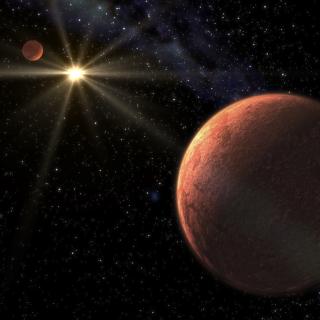Bibcode
Sarkis, P.; Henning, Thomas; Kürster, Martin; Trifonov, Trifon; Zechmeister, Mathias; Tal-Or, Lev; Anglada-Escudé, Guillem; Hatzes, Artie P.; Lafarga, Marina; Dreizler, Stefan; Ribas, Ignasi; Caballero, José A.; Reiners, Ansgar; Mallonn, Matthias; Morales, Juan C.; Kaminski, Adrian; Aceituno, Jesús; Amado, Pedro J.; Béjar, V. J. S.; Hagen, Hans-Jürgen; Jeffers, Sandra; Quirrenbach, Andreas; Launhardt, Ralf; Marvin, Christopher; Montes, David
Bibliographical reference
The Astronomical Journal, Volume 155, Issue 6, article id. 257, 18 pp. (2018).
Advertised on:
6
2018
Citations
71
Refereed citations
60
Description
K2-18 is a nearby M2.5 dwarf, located at 34 pc and hosting a transiting
planet that was first discovered by the K2 mission and later confirmed
with Spitzer Space Telescope observations. With a radius of ∼2 R
⊕ and an orbital period of ∼33 days, the planet
lies in the temperate zone of its host star and receives stellar
irradiation similar to that of Earth. Here we perform radial velocity
follow-up observations with the visual channel of CARMENES with the goal
of determining the mass and density of the planet. We measure a
planetary semi-amplitude of K b ∼ 3.5 {{m}}
{{{s}}}-1 and a mass of M b ∼ 9 M
⊕, yielding a bulk density around {ρ
}b∼ 4 {{g}} {cm}}-3. This indicates a low-mass
planet with a composition consistent with a solid core and a
volatile-rich envelope. A signal at 9 days was recently reported using
radial velocity measurements taken with the HARPS spectrograph. This was
interpreted as being due to a second planet. We see a weaker, time- and
wavelength-dependent signal in the CARMENES data set and thus favor
stellar activity for its origin. K2-18 b joins the growing group of
low-mass planets detected in the temperate zone of M dwarfs. The
brightness of the host star in the near-infrared makes the system a good
target for detailed atmospheric studies with the James Webb Space
Telescope.
Related projects

Very Low Mass Stars, Brown Dwarfs and Planets
Our goal is to study the processes that lead to the formation of low mass stars, brown dwarfs and planets and to characterize the physical properties of these objects in various evolutionary stages. Low mass stars and brown dwarfs are likely the most numerous type of objects in our Galaxy but due to their low intrinsic luminosity they are not so
Rafael
Rebolo López

Exoplanets and Astrobiology
The search for life in the universe has been driven by recent discoveries of planets around other stars (known as exoplanets), becoming one of the most active fields in modern astrophysics. The growing number of new exoplanets discovered in recent years and the recent advance on the study of their atmospheres are not only providing new valuable
Enric
Pallé Bago